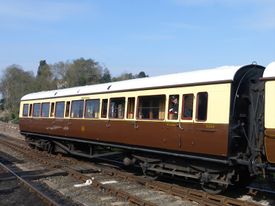GWR 9369 Nondescript Saloon
| GWR 9369 Nondescript Saloon | |
|---|---|
 GWR 9369 Nondescript Saloon | |
| Built By | GWR Swindon |
| Status | In service |
| Number | 9369 |
| Other numbers | DW150128 |
| History | |
| Built | 1923 |
| Designed By | Collett |
| Diagram | G56 |
| Lot | 1250 |
| Type | Nondescript, BTO |
| Length | 56ft 11¼in |
| Weight | 27t 11cwt |
| Seats | 40 unclassified (as built) |
| 1972 | Preserved on SVR |
GWR Nondescript Saloon 9369 was one of a batch of three ordered in 1915 as successors to the 1912 Churchward 'toplight' prototype 9055, but due to the First World War they were not delivered until 1923, by which time Collett had succeeded Churchward as CME. Like the prototype, 9369 was an unclassified or 'nondescript' saloon (i.e. not allocated to any specific class such as first or third) and was used for private hire, although unlike the prototype, it did not actually have toplight windows.
Contents
Layout
From the near end as seen, the layout of 9369 comprises a toilet, two saloons with exterior doors at each end and an interconnecting door, a single compartment with an exterior door, a brake/luggage compartment with double doors and another toilet. On the far side as seen, the side corridor has a matching external door layout. The two saloons each seat 16 passengers and the compartment seats 8 for a nominal total capacity of 40. The brake compartment allowed the carriage to be attached and detached at any station and to be parked,[1] although in service this was probably mainly used for storage of hampers rather than as accommodation for a guard.
As built, the saloons bore similarity internally to contemporary London Underground surface stock, being finished in Edwardian-style mahogany woodwork with inward-facing bench type seats along each side. Between the bench seats was a central folding table which made access to the seats somewhat awkward. The upholstery was a dark brown moquette, the standard for first class in the period. Externally the Collett version displays the characteristics of the GWR 'bow-ended' era, without the 'toplight' windows of the prototype.[2] Other changes made by Collett from the prototype included placing the two saloons next to each other with an interconnecting door (which had the incidental effect of reducing the capacity from 44 seats to 40) and the addition of the brake in the luggage compartment. The internal layout is similar to the third Nondescript Saloon on the SVR, 9103 of 1929.
Service and preservation
9369 spent most of its service life at Bristol. The late Frank Kimberley remembered the coach in its original 1923 livery when, as a boy, his choir chartered the coach for a day trip. Frank would later be part of the team who would restore it in preservation.[3]
9369 was withdrawn from passenger service by BR(W) circa January 1958 and transferred into Departmental stock as number DW 150128. After a number of internal structural changes, it was then used as a 'mobile office', initially at Shrewsbury and later at Norton Junction, Walsall.
9369 was originally purchased by a private owner, Mr John Tarrant. It was delivered from Walsall to Kidderminster yard in June 1972, moving to Bewdley for its official arrival on the SVR on 6 September 1972.[4][note 1] Only one saloon had remained intact although in a damaged state, while the other saloon, the compartment, the brake and the two lavatories were in need of complete rebuilding.
A 10-year restoration at Bewdley by a small team led by John Tarrant began soon after arrival. By 1975 the body framework has been repaired and the panels below the waist replaced, mainly re-using roof panels from Autotrailer No 160 which had been broken up for spares shortly after arrival in 1969. Once the re-panelling was complete, work concentrated on rebuilding the interior. In autumn 1980, with internal restoration still not fully complete, 9369 was one of the two carriages used for filming The Good Soldier having received a coat of chocolate and cream and a couple of numbers.[5]
With restoration completed, 9369 entered traffic in 1983 carrying Collett's simplified Chocolate and Cream livery with single waistband lining. In late 1985 it was taken into Bewdley paint shop for an external repaint but then pressed back into service for two weeks' filming of Granada TV's 'Lost Empires'. It returned "in a messy state", meaning both the exterior and interior required repainting. On this occasion it received the elaborate 1923 style livery with full pseudo panel lining and garter crest, the first in preservation to be so treated.[6]
9369 underwent a further overhaul in 1993 including a new roof canvas and attention to the window frames on the corridor side. John Tarrant also agreed to a change from the 'as built 1923' fully lined livery to the more plain 1928 livery.[7] A bogie overhaul and 'touch up and varnish' was carried out in 2000.[8]
Owner John Tarrant sadly died in 2002.[9] John was a member of the Great Western (SVR) Association who now own the coach.
9369 was moved into Kidderminster carriage works for a bogie overhaul and other work in September 2016. The paint shop staff, decided to withdraw the coach from service due to the state of the doors and bodywork in the lavatory area.[10]. It is normally seen in the Toplights set, but it is finished in GWR 1934-42 livery featuring the ‘shirt-button’ roundel.
See also
Notes
References
Links
| ||||||||||||||||||||||||||||||